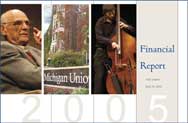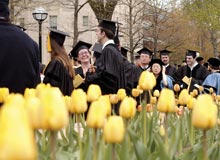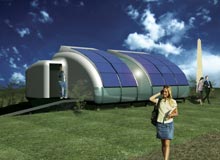

The U-M believes that education is paramount for young men and women, which is why undergraduate education is the core mission of the University. Here are some initiatives directly affecting student life and education:
 A U-M college education for Michigan residents will now be more accessible, thanks to a new financial aid program that increases grants and reduces loans for more than 2,900 students. The University will provide an initial $3 million per year in seed money to jump-start the program, called M-PACT. The program increases the need-based grant assistance for students showing the greatest financial need.
A U-M college education for Michigan residents will now be more accessible, thanks to a new financial aid program that increases grants and reduces loans for more than 2,900 students. The University will provide an initial $3 million per year in seed money to jump-start the program, called M-PACT. The program increases the need-based grant assistance for students showing the greatest financial need.
“M-PACT is one more way that the University of Michigan will continue to deliver on its longstanding commitment to accessibility and diversity,” President Mary Sue Coleman said. “We are determined to tear down the barrier of cost for Michigan students of every financial circumstance.” The program will be open to all income-eligible Michigan resident undergraduates for the fall 2005 semester.
U-M’s Ann Arbor campus can expect another large freshman class in the fall with a significantly greater number of minority students. This reverses a drop in African American enrollment that occurred last year after the undergraduate admissions process was revised.
Theodore L. Spencer, director of undergraduate admissions, said the incoming class will have even stronger academic credentials than last year’s group. “I am tremendously impressed by the quality of the students who chose to apply to Michigan this year. Our individualized review process is giving us the opportunity to learn so much about each of them, and to admit the students who are deeply interested in Michigan and who can make a unique contribution to our campus.”
In September 2004, U-M launched “U-M en Español,” a Spanish-language web portal that opens the University’s door more widely to Latino Americans, the nation’s fastest-growing population group.
“Research demonstrates that language is a major obstacle to accessing higher education for many Latino students,” said Lester Monts, senior vice provost for academic affairs and senior counselor to the president for the arts, diversity, and undergraduate affairs. “This site will help to remove that obstacle.”
The site provides valuable information to prospective students and their families about applying to Michigan, academic requirements, financial aid, housing, and campus and Ann Arbor resources. For more information visit the site at http://www.umich.edu/ES.
A comprehensive plan for student housing calls for building the first new residence hall in more than 35 years and making extensive renovations to other facilities. New projects include:
 Architecture student Jim Kumon and a team of more than 50 U-M students are building the home of the future: a 700-square-foot solar-powered house using commonly available materials that can handle the basic power needs of a small home. The Michigan Solar House Project (MiSo), is U-M’s entry in a national solar house contest sponsored by the U.S. Energy Department.
Architecture student Jim Kumon and a team of more than 50 U-M students are building the home of the future: a 700-square-foot solar-powered house using commonly available materials that can handle the basic power needs of a small home. The Michigan Solar House Project (MiSo), is U-M’s entry in a national solar house contest sponsored by the U.S. Energy Department.
A College of Engineering team won an EPA “P3 Award” in May for its sustainability project called AWARE@home. The computer-based tool lets homeowners monitor utility consumption in real time. The consumers can then measure the costs and impact of conservation measures in their homes.
Wei Gu used to write computer software for the electronic games he liked to play. Today the U-M senior uses his programming skills to write computer instructions that direct cells and other fluids through channels on a microchip, so that those cells think they’re in the body. The research earned Gu a first place in the undergraduate category of the Collegiate Inventor’s Competition in October 2004 and the Proceedings of the National Academy of Sciences has accepted his paper on the findings for publication.
Joseph Jewell, a graduate student in aerospace, was one of 32 U.S. students awarded a Rhodes Scholarship in fall 2004. The 23-year-old is an honors student who scored a perfect 1600 on the SAT, as well as an accomplished musician and student government leader. At Oxford, he will pursue a research master’s in engineering, but will also play timpani in the symphony.
Physics student Jacob Bourjaily is one of eight students from the Midwest selected for the highly competitive Marshall Scholarship for 2005. About 40 American students are selected annually to study at the British university of their choice.
LSA student Christopher Hayward was selected as one of only 11 students in the country to receive a prestigious Churchill Scholarship for the 2005–06 academic year. Hayward, who studies mathematics, physics, and astronomy, will attend Churchill College at Cambridge University, where he plans to take courses in applied mathematics and theoretical physics.
Eighteen U-M students won Fulbright Awards in 2004–05, ranking Michigan No. 1 among Midwest regional schools. Nationally, U-M tied for second with the University of Texas at Austin. The Fulbright provides funding for one academic year of study or research abroad, to be conducted after graduation from an accredited university.
The School of Music sent a delegation of students to perform at the John F. Kennedy Center for the Performing Arts in Washington, D.C. They were guests of the Center’s Conservatory Project, which invites the best young artists from the nation’s leading music institutions to perform in a series of concerts
They are high achievers, both academically and in extracurricular activities. They include gifted musicians, aspiring writers, community activists, talented athletes, and entrepreneurs. They are diverse, representing a multitude of races, cultures, ethnicities, and religions. The students who enrolled in September 2004 came from all 50 states and 45 countries. They are the Class of 2008: 5,500 students selected from a group of 21,000, and one of the most well-qualified applicant pools in the University’s history.
57% had 3.8 or higher GPAs
90% ranked in the top 10% of their graduating class
35% were members of a high school academic honor society
55% play a musical instrument
28% were active in high school government
25% had writing published or were editors of high school
publications
30% have won awards for community service
10% have started their own businesses
25% have won all-city, regional, state, or national athletic
awards
| ANN ARBOR | |
| Undergraduate | 24,828 |
| Graduate | 14,705 |
| Total | 39,533 |
| DEARBORN | |
| Undergraduate | 6,449 |
| Graduate | 2,182 |
| Total | 8,631 |
| FLINT | |
| Undergraduate | 5,620 |
| Graduate | 568 |
| Total | 6,188 |
| ALL CAMPUSES | |
| Undergraduate | 36,897 |
| Graduate | 17,445 |
| Total | 54,352 |
| ANN ARBOR | |
| Undergraduate | 5,880 |
| Graduate | 4,972 |
| Total | 10,852 |
| DEARBORN | |
| Undergraduate | 1,315 |
| Graduate | 619 |
| Total | 1,934 |
| FLINT | |
| Undergraduate | 907 |
| Graduate | 206 |
| Total | 1,113 |
| ALL CAMPUSES | |
| Undergraduate | 8,102 |
| Graduate | 5,797 |
| Total | 13,899 |